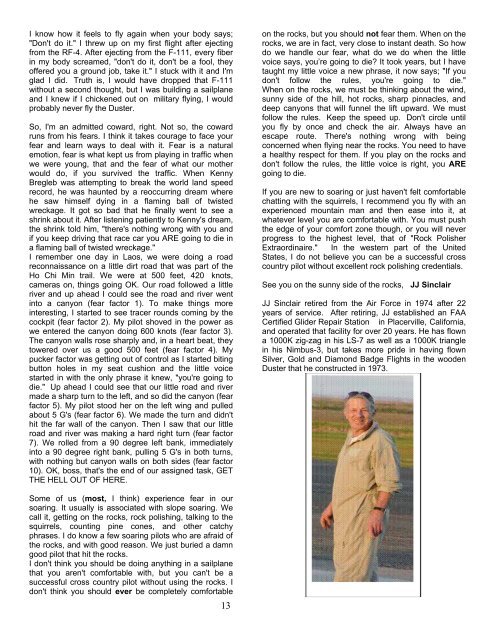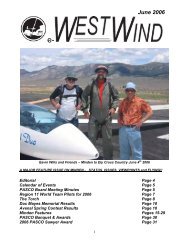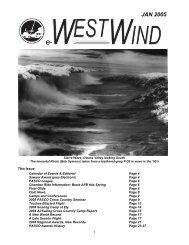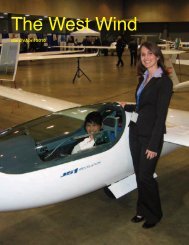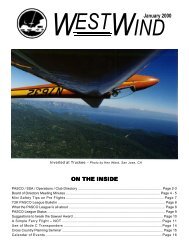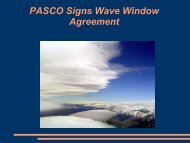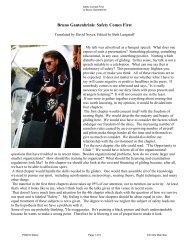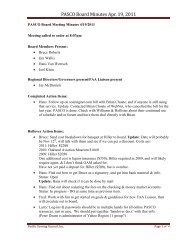2006 March (529kB) - Pacific Soaring Council
2006 March (529kB) - Pacific Soaring Council
2006 March (529kB) - Pacific Soaring Council
You also want an ePaper? Increase the reach of your titles
YUMPU automatically turns print PDFs into web optimized ePapers that Google loves.
I know how it feels to fly again when your body says;<br />
"Don't do it." I threw up on my first flight after ejecting<br />
from the RF-4. After ejecting from the F-111, every fiber<br />
in my body screamed, "don't do it, don't be a fool, they<br />
offered you a ground job, take it." I stuck with it and I'm<br />
glad I did. Truth is, I would have dropped that F-111<br />
without a second thought, but I was building a sailplane<br />
and I knew if I chickened out on military flying, I would<br />
probably never fly the Duster.<br />
So, I'm an admitted coward, right. Not so, the coward<br />
runs from his fears. I think it takes courage to face your<br />
fear and learn ways to deal with it. Fear is a natural<br />
emotion, fear is what kept us from playing in traffic when<br />
we were young, that and the fear of what our mother<br />
would do, if you survived the traffic. When Kenny<br />
Bregleb was attempting to break the world land speed<br />
record, he was haunted by a reoccurring dream where<br />
he saw himself dying in a flaming ball of twisted<br />
wreckage. It got so bad that he finally went to see a<br />
shrink about it. After listening patiently to Kenny's dream,<br />
the shrink told him, "there's nothing wrong with you and<br />
if you keep driving that race car you ARE going to die in<br />
a flaming ball of twisted wreckage."<br />
I remember one day in Laos, we were doing a road<br />
reconnaissance on a little dirt road that was part of the<br />
Ho Chi Min trail. We were at 500 feet, 420 knots,<br />
cameras on, things going OK. Our road followed a little<br />
river and up ahead I could see the road and river went<br />
into a canyon (fear factor 1). To make things more<br />
interesting, I started to see tracer rounds coming by the<br />
cockpit (fear factor 2). My pilot shoved in the power as<br />
we entered the canyon doing 600 knots (fear factor 3).<br />
The canyon walls rose sharply and, in a heart beat, they<br />
towered over us a good 500 feet (fear factor 4). My<br />
pucker factor was getting out of control as I started biting<br />
button holes in my seat cushion and the little voice<br />
started in with the only phrase it knew, "you're going to<br />
die." Up ahead I could see that our little road and river<br />
made a sharp turn to the left, and so did the canyon (fear<br />
factor 5). My pilot stood her on the left wing and pulled<br />
about 5 G's (fear factor 6). We made the turn and didn't<br />
hit the far wall of the canyon. Then I saw that our little<br />
road and river was making a hard right turn (fear factor<br />
7). We rolled from a 90 degree left bank, immediately<br />
into a 90 degree right bank, pulling 5 G's in both turns,<br />
with nothing but canyon walls on both sides (fear factor<br />
10). OK, boss, that's the end of our assigned task, GET<br />
THE HELL OUT OF HERE.<br />
on the rocks, but you should not fear them. When on the<br />
rocks, we are in fact, very close to instant death. So how<br />
do we handle our fear, what do we do when the little<br />
voice says, you’re going to die? It took years, but I have<br />
taught my little voice a new phrase, it now says; "If you<br />
don't follow the rules, you're going to die."<br />
When on the rocks, we must be thinking about the wind,<br />
sunny side of the hill, hot rocks, sharp pinnacles, and<br />
deep canyons that will funnel the lift upward. We must<br />
follow the rules. Keep the speed up. Don't circle until<br />
you fly by once and check the air. Always have an<br />
escape route. There's nothing wrong with being<br />
concerned when flying near the rocks. You need to have<br />
a healthy respect for them. If you play on the rocks and<br />
don't follow the rules, the little voice is right, you ARE<br />
going to die.<br />
If you are new to soaring or just haven't felt comfortable<br />
chatting with the squirrels, I recommend you fly with an<br />
experienced mountain man and then ease into it, at<br />
whatever level you are comfortable with. You must push<br />
the edge of your comfort zone though, or you will never<br />
progress to the highest level, that of "Rock Polisher<br />
Extraordinaire." In the western part of the United<br />
States, I do not believe you can be a successful cross<br />
country pilot without excellent rock polishing credentials.<br />
See you on the sunny side of the rocks, JJ Sinclair<br />
JJ Sinclair retired from the Air Force in 1974 after 22<br />
years of service. After retiring, JJ established an FAA<br />
Certified Glider Repair Station in Placerville, California,<br />
and operated that facility for over 20 years. He has flown<br />
a 1000K zig-zag in his LS-7 as well as a 1000K triangle<br />
in his Nimbus-3, but takes more pride in having flown<br />
Silver, Gold and Diamond Badge Flights in the wooden<br />
Duster that he constructed in 1973.<br />
Some of us (most, I think) experience fear in our<br />
soaring. It usually is associated with slope soaring. We<br />
call it, getting on the rocks, rock polishing, talking to the<br />
squirrels, counting pine cones, and other catchy<br />
phrases. I do know a few soaring pilots who are afraid of<br />
the rocks, and with good reason. We just buried a damn<br />
good pilot that hit the rocks.<br />
I don't think you should be doing anything in a sailplane<br />
that you aren't comfortable with, but you can't be a<br />
successful cross country pilot without using the rocks. I<br />
don't think you should ever be completely comfortable<br />
13


